




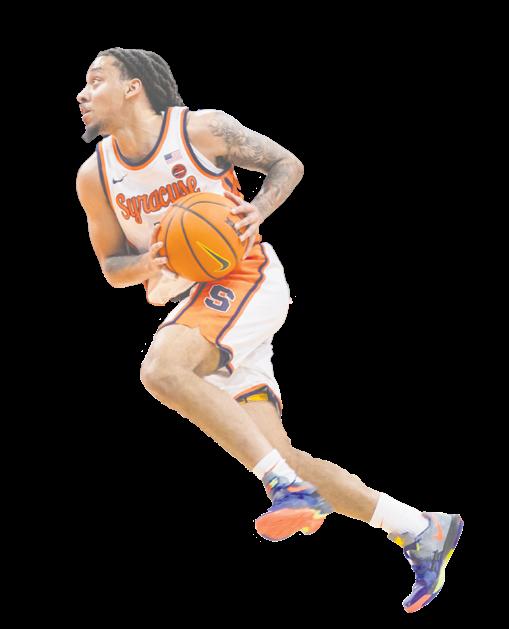
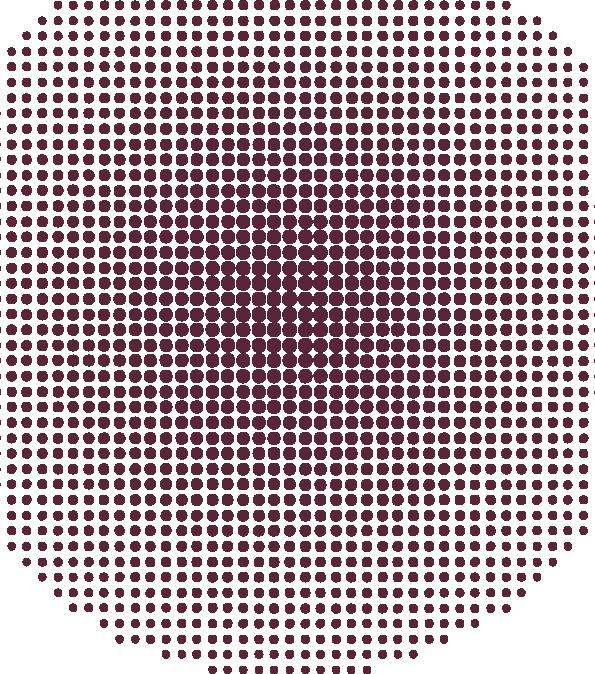

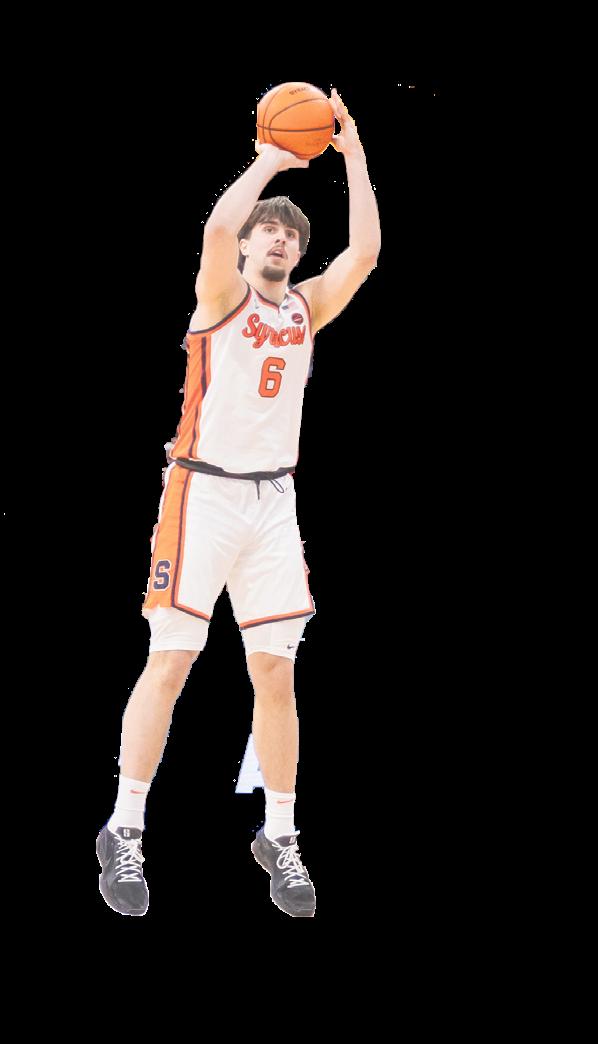

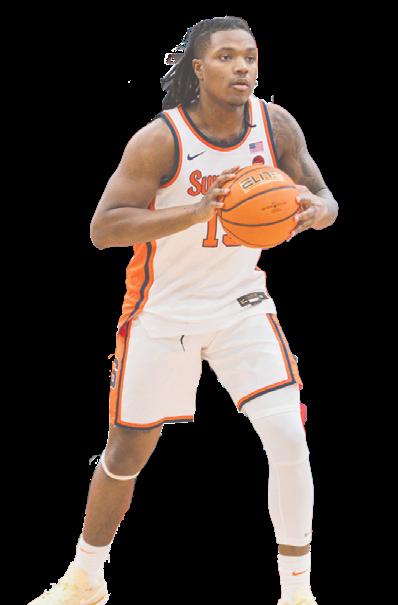

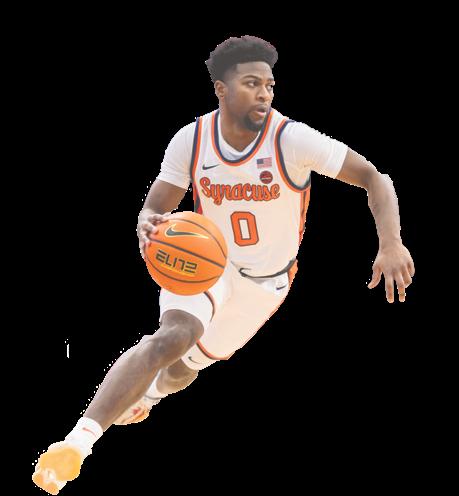


Editor@dailyorange.com
News@dailyorange.com
Opinion@dailyorange.com
Culture@dailyorange.com
Sports@dailyorange.com
Digital@dailyorange.com
Design@dailyorange.com
Photo@dailyorange.com
The Daily Orange is an independent, nonprofit newspaper published in Syracuse, New York. The editorial content of the paper — which started in 1903 and went independent in 1971 — is entirely run by Syracuse University students.
The D.O., a 501(c)(3) nonprofit, is editorially and financially independentfromSU,andthepaperreceivesnofundingfromthe university. Instead, The D.O. relies on advertising revenue and donations to sustain operations.
This fall, the paper will be published Thursday when SU classes are in session. The D.O.’s online coverage is 24/7, including while SU is on break.
To show your support to The D.O.’s independent journalism, please visit dailyorange.com/donate. Donations are tax deductible.

Dear readers,
Syracuse men’s basketball has struggled in Adrian Autry’s second season as head coach, ranking 14th in the Atlantic Coast Conference with six games remaining. Meanwhile, North Carolina was picked to finish second in the ACC’s Preseason Poll but has gotten out to an average 7-6 record in conference play.
Saturday’s matchup is pivotal for both programs. SU is trying to create breathing room toward qualifying for the ACC Tournament with a win, while UNC is attempting to keep its NCAA Tournament-hopeful resume intact.
The Daily Orange has everything you need to know before Syracuse’s ACC clash against North Carolina.
Thanks for reading,
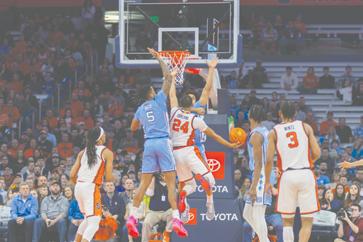


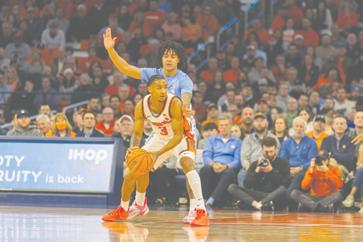
Syracuse upset then-No. 7 North Carolina 86-79 on Feb. 13, 2024. It was SU’s first victory over an AP Top 10 opponent since 2019 and remains the program’s best win across Adrian Autry’s 57-game tenure as head coach.
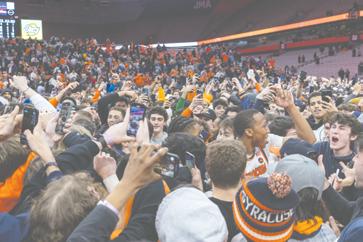
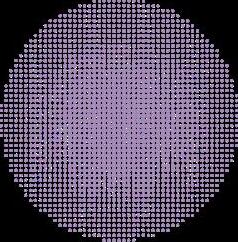


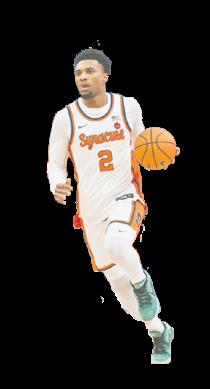
18.6


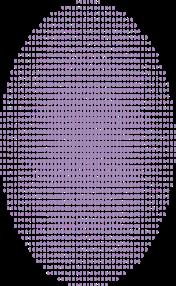
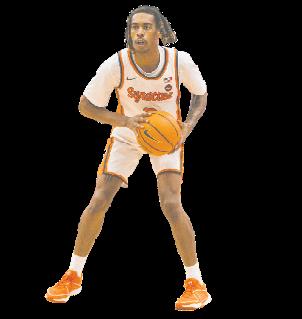
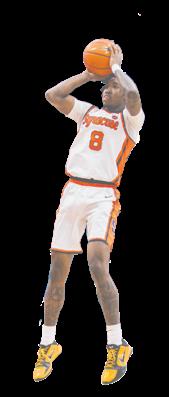
5.8




3.8 ASSISTS PER GAME 2.5 ASSISTS PER GAME 2.4 ASSISTS PER GAME 1.4 ASSISTS PER GAME 0.7 ASSISTS PER GAME 1.0 REBOUNDS PER GAME 9.4 REBOUNDS PER GAME 5.1 REBOUNDS PER GAME

Syracuse is coming off its most embarrassing loss of the season, a 91-84 defeat to Miami. Prior to Tuesday, Miami had just five wins on the season and one victory in Atlantic Coast Conference play. Though, the Hurricanes made it look easy against SU. The Orange didn’t lead until the second half, but it was a brief advantage. They allowed Miami to shoot 55% from the field and hit 10 3-pointers.
J.J. Starling led the way with 25 points for Syracuse, albeit on an inefficient 8-of-21 shooting performance, while Eddie Lampkin Jr. added 22. Starling and Lampkin’s scoring wasn’t enough as the Orange failed to separate themselves from the bottom three in the ACC standings.
Next up for SU is North Carolina. Despite having a down season, the Tar Heels still present many problems for the Orange, including their potent offense.
Here’s how our beat writers feel Syracuse (11-14, 5-9 ACC) will fare against North Carolina (14-11, 7-6 ACC) Saturday in the JMA Wireless Dome:
Prior to Syracuse’s outing against Miami, I was extremely tempted to pick the Orange in this one. In the back of my mind, I thought about my good friend Tyler Schiff’s prediction from last season where he picked the Orange to defeat then-No. 7 North Carolina. Nobody believed him, but he didn’t care. UNC isn’t nearly as good this season, so it wasn’t as much of a bold prediction to pick SU. After watching Syracuse play Miami Tuesday, I can’t pick it to win.
The Orange put on one of the most embarrassing defensive displays I’ve seen, allowing Miami to score at will. North Carolina has one of the best offenses in the ACC, 80 points per game, and the Tar Heels will receive little resistance from SU. North Carolina’s three-guard lineup of RJ Davis, Elliot Cadeau and Seth Trimble, along with Drake Powell and Ian Jackson off the bench, will feast. My original reasoning for possibly picking SU was its advantage in the frontcourt. I felt Lampkin and even Jyáre Davis could take advantage of favorable matchups down low. That’s no longer the case. No person with any logic can pick the Orange in this game after what they saw on Tuesday. It won’t happen this season, but I truly don’t know how many more losses like that Adrian Autry can take.

2.3 REBOUNDS PER GAME 1.5
5.4 REBOUNDS PER GAME

Wow. Just when I thought Syracuse’s season couldn’t get worse, it fell to the ACC’s bottom feeder in Miami. As Zak said, this was a tempting pick in Syracuse’s favor a few days ago. While a home crowd and no UNC inside presence still make it tempting, I can’t find any excuse to pick Orange after the embarrassment that ensued Tuesday.
The Tar Heels — while losers of five of their last seven games — possess a potent offense with the guard play of Davis, Cadeau and Jackson. For UNC’s standards, this is a down year. However, a bad year for North Carolina still sees it among the upper-echelon of offenses in the conference. Syracuse clearly isn’t a team that can stop anything right now. It might be able to score some points with Lampkin inside, but it won’t be enough.
As I confidently picked the Orange to take down the Hurricanes just a few days ago, I said a Syracuse loss to Miami would be the ultimate embarrassment of the season. I also said that a loss in Florida would make me believe for the first time that Autry’s on the hot seat. Welp, here we are. While I’m not calling for Autry’s job, the noise from the outside is only continuing to heat up. A loss to the Tar Heels won’t help it.

Every Monday when Autry speaks to the media over Zoom, it’s impossible not to notice the “#OrangeStandard” phrase written in his office. It’s what he preached he’d work to get SU back to. Yet in year two, the Orange have continuously crept away from the “Orange Standard.”
Tuesday’s loss to Miami was another painful reminder. In what hypothetically should’ve been a walk in the park for Syracuse facing the worst team in the conference, it entered the game as a betting underdog. I was honestly appalled. But the Orange showed throughout why they weren’t expected.
As my fellow beat writers have pointed out, North Carolina isn’t the North Carolina we expected it to be entering the year. However, UNC doesn’t need to be a blue blood to beat this iteration of SU. It just needs to not play like it’s one of the worst teams in the country — which it’s more than capable of even with an underachieving roster.
This all begs a question for me: what is Syracuse’s standard? The standard should be competing with the blue blood programs. Maybe just a close game against a middling Tar Heels squad would be deemed a success for the Orange.

Alex Kline’s NBA career began on his University Village apartment’s couch, eating Ben & Jerry’s ice cream, making phone calls and writing reports for the 2016 NBA Draft. Dealing with mononucleosis throughout his final college semester at Syracuse University, Kline served as a part-time consultant for the New Orleans Pelicans.
On winter break before the semester, Kline was texting Pelicans scout Yarone Arbel while vacationing with friends in Orlando. Because New Orleans was in town to play the Magic, Arbel set up a meeting with Kline to speak with general manager Dell Demps. It sparked a four-year run for Kline in the organization, where he was re-hired as a scout entering the 2016-17 season.
But, when a higher role with the New York Knicks was offered by a new front office — led by Team President Leon Rose — in 2020, he took the position and helped rebuild the organization. Despite thriving, Kline’s life changed when SU assistant coach Allen Griffin called him in the summer of 2023, hypothetically suggesting he should become Syracuse men’s basketball’s general manager.
Kline thought about the role “every second of every day” until he officially became SU’s GM on June 28, 2024.
“Maybe it’s ADHD,” Kline said, “I’m just always looking for, ‘What’s the next challenge? What’s the next opportunity?’”
Kline, 31, became a basketball wunderkind through his uncanny scouting ability, deep-rooted connections and innovative mindset. It’s led him back to Syracuse, where his newest challenge is constructing a winning roster as the program’s first GM. By embracing and helping transform college basketball’s new era, Kline is crucial in attempting to bring SU — which is on the verge of missing its fourth straight NCAA Tournament — back to the “Orange Standard.”
“The way he’s wired is to take on new challenges,” agent Daniel Poneman, who has known Kline since he was 14, said. “For him to not be able to take on new challenges, it’d be like telling LeBron James to stop taking jump shots.”
Before conquering the NBA, Kline transformed high school basketball. As a 14-year-old, he created The Recruit Scoop, a cutting-edge recruiting website and social media platform that landed him a partnership with Rivals.com. He also founded the Mary Kline Classic and Mary Kline Classic Sports & Business Symposium, raising nearly $200,000 for cancer research in honor of his late mother, Mary, who died when he was 10.
With a pivotal third year approaching for head coach Adrian Autry, Kline’s experiences make him the perfect person to lead Syracuse’s front office and modernize the program.
“If you had 200 people apply for that job, there’s no doubt in my mind Alex is the most qualified to do it,” Adrian Wojnarowski, who retired from ESPN to become St. Bonaventure’s general manager in September 2024, said.
Four years before Duke hired Rachel Baker as college basketball’s first GM in 2022, Kline
conversed with now-Harvard Director of Basketball Operations Tripp Doherty about why the role was needed, viewing college basketball as similar to a corporation.
NBA coaches specialize in their strengths and leave other areas to the front office, a luxury college coaches previously didn’t have. The transfer portal and Name, Image and Likeness’ emergence forced college basketball front-office roles into fruition.
Now, there are over 25 general managers in Division I basketball. Unlike the NBA, not all college basketball GMs — or similar Chief Program Strategist or Director of Basketball Operations positions — follow the same structure. This allows the job to be centered around the strengths of whoever holds the position. For Kline, that’s in scouting and talent evaluation.
“Who better to give a very intelligent opinion than someone that’s been on that side in the draft room for two successful organizations?” Doherty said of Kline.
While playing a role in personnel decisions with the Pelicans and Knicks was the norm for Kline, he didn’t have any input upon arriving at Syracuse — its 2024-25 roster was already built. Kline’s first season as a GM has entailed doing behind-the-scenes research, making scouting trips and sitting in the second row of SU’s bench to scout during games.
He’ll have his first chance to start crafting his roster when the portal opens after the season.
Though Kline is SU’s only full-time front office staffer, it hired 21-year-old Eugene Tulyagijja as a Data Analyst to be a hybrid coach and front office member.
To pair with Kline’s scouting prowess, Tulyagijja and Kline worked together to build an algorithm to help identify and quantify talent. The algorithm is built around Kline’s scouting experience and Tulyagijja’s prior work with the Cleveland Cavaliers’ analytics department — modeling it around what worked at the NBA level.
This offseason will be the first time SU has fully used the algorithm, but Tulyagijja said it’s how the Orange found Luke Fennell and Aaron Womack in the high school circuit. Heading into last year’s portal season, Tulyagijja revealed Syracuse dove into each player’s analytics but didn’t use a specific algorithm.
“With Alex here now, I think the model hopefully is more efficient this time around,” Tulyagijja said. “Understanding that having all the money in the world, if you can’t talent evaluate, it’s not going to do you anything.”
In college basketball’s unregulated marketplace, at least until revenue sharing potentially becomes legalized, Kline feels many of the negotiated deals are “make-believe.” But he feels Syracuse “absolutely” has the budget to be competitive NIL-wise.
Still, Kline says his inspiration is the Moneyball Oakland Athletics and Tampa Bay Rays, acknowledging Southeastern Conference and Big Ten programs have “insane bank accounts.” So, SU must be sharper and more strategic to maximize its resources at a crucial moment to add talent alongside the program’s highest-rated incoming recruiting class since 2015.
“I think every move we make is paramount,” Kline said. “Every move we make should have a huge impact. There should be meaning behind it. There should be reasoning behind it.”
An essential part of succeeding, in Kline’s mind, is being aligned with Autry. He can make as many recommendations to the head coach as he wants, but if a player doesn’t fit Autry’s system, the addition won’t work. Kline credits his time working with Knicks head coach Tom Thibodeau as what will help him work with Autry.
Across Kline’s four-year stint, the Knicks went from the Eastern Conference’s gutter to one of its premiere teams by understanding the archetypes that best fit Thibodeau’s system.
“Alex has brought us a wealth of experience and knowledge in the basketball profession, ” Autry said.
Throughout the season, Kline has been in consistent contact with Autry and Syracuse’s coaching
staff, updating them on his intel and bouncing ideas off them to see if there’s synergy between everyone. When the portal opens, Kline and Autry will negotiate with players and agents.
Kline’s relationships across all landscapes of basketball are primed to help Syracuse garner top talent.
“It’s huge,” Daniel Marks, Howard’s Chief Program Strategist since 2022, said of Kline’s connections. “He’s known high school and AAU coaches for almost 15 years now at a really high level.”
Between agents, executives, coaches and players, Kline building a vast network is how he broke into the NBA. Getting in touch with Arbel stemmed from Kline attending a Reebok event in Biloxi, Mississippi, in 2015.
There, he met Scott Robinson, an AAU coach who was coaching future first-round pick Skal Labissière. When Robinson asked Kline, then a senior at SU, what his goals were, he said work in the NBA. So, Robinson connected him to Dan Connelly — then an independent trainer and the younger brother of heralded NBA executive Tim Connelly. Dan then connected him with Arbel, who referred him to Demps.
Following a 30-minute meeting with Demps, Kline finally had clarity on what his future could
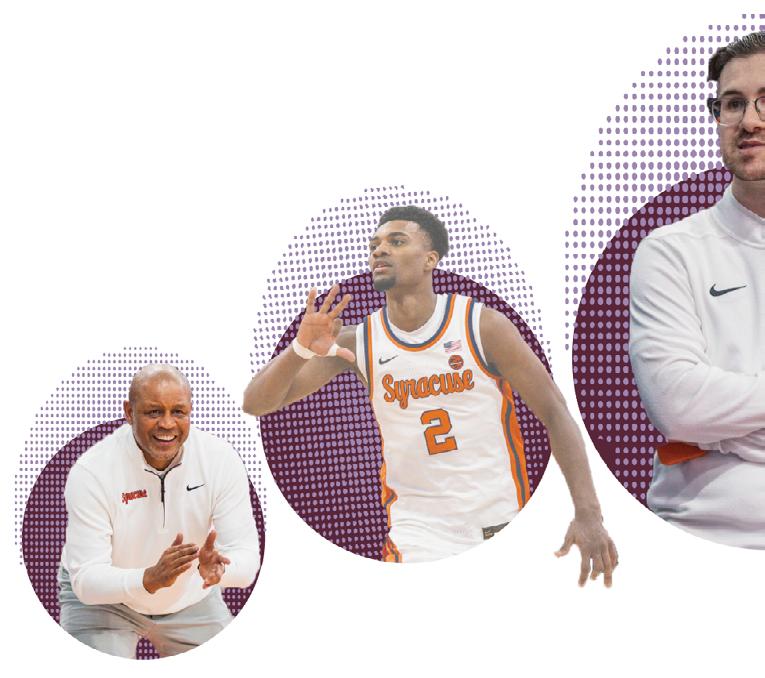
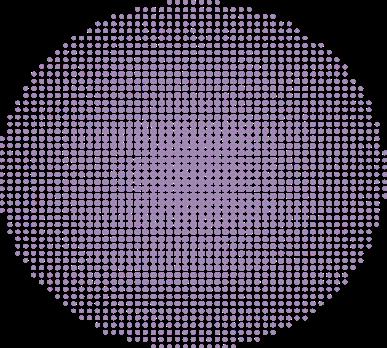
By Justin Girshon

be. Kline always aimed to work in basketball, though he wasn’t sure what that would entail.
“There was always that question in the back of your mind,” Kline said. “More so my father than myself of like, ‘What are you actually going to do with this, and how are you going to make money? And how are you going to turn it into something?’”
He loved basketball for what it was, never worrying about where it could take him. From an early age, sports helped “save his life” while his mother battled cancer. In high school, basketball returned the favor to Kline. It gave him purpose, confidence and friendships.
As an eighth grader, Kline approached his math teacher, Bernie Gurick, who served as Pennington High School’s (New Jersey) varsity coach for 30 years. He told Gurick he liked statistics and understood the game, wanting to join the program.
It resulted in Kline becoming a manager in ninth grade. Initially, he was a water boy and did the team’s laundry. However, he quickly became “unlike any student” Gurick had ever worked with. Between helping the players on the court during practice and gathering intel on opponents
analytically and on film, Gurick lauded Kline’s impact on Pennington.
“He was beyond his years,” Gurick said. “He just was a go-getter. And if he put his mind to something, he was going to do it.”
Around the same time he became a manager, Kline and a friend created Box of M.E.S.S. — a “music,” “entertainment,” “sports” and “stuff” website. Quickly, Kline found a way to mix in basketball, interviewing top basketball recruits, including Kyrie Irving, Dion Waiters and Harrison Barnes.
Kline went all in on basketball toward the end of his sophomore year, transforming Box of M.E.S.S. into The Recruit Scoop. As his reputation grew, so did his talent evaluation skills.
“Who better than Alex to get information and to evaluate players? He has a unique style to evaluate,” Paul Biancardi, ESPN’s National Director of Recruiting, said.
Once he became a manager for Pennington, Kline bonded with players and questioned their packed weekend schedules. When they claimed AAU basketball kept them busy, he thought it was “total bullsh*t.”
The players encouraged Kline to travel with them across the country to tournaments. So, Kline accepted, often crammed in the back of a van on a suitcase without a seatbelt. In hotels, Kline “did whatever it took,” often sleeping on chairs and floors.
“What it was I was looking for, I have no idea,” Kline said of his aspirations at the time.
Kline’s notoriety and credibility rapidly began increasing the more he traveled. College coaches came to him for intel. Meanwhile, Kline greatly appealed to players, often being trusted to break news or give them feedback on how to improve their games. The Recruit Scoop turned into essentially
a precursor to what On3 and Joe Tipton do, except through scouting.
“Just picking his brain and seeing that, ‘OK, no, he’s not just a fanatic.’ I mean, he’s a fanatic, but he knows what he’s talking about,” Chase Plummer, Irving’s teammate at St. Patrick High School (New Jersey), said of Kline’s trustworthiness. “He knows exactly what he’s talking about and what needs to be done.”
“I respected his basketball opinion, and I still do, nothing’s changed to that point,” Tyler Roberson, a former SU player from 2013-17 who knew Kline before his college career, added.
As Kline grew in notoriety, he wanted to give back. So, he created the Mary Kline Classic, a high school basketball showcase similar to the McDonald’s All-American game. From 2011-16, players including Karl-Anthony Towns, Josh Hart, Michael Porter Jr., Donovan Mitchell and Mikal Bridges participated.
Despite Kline’s high school success, he wasn’t getting basketball scholarships like many players he’d covered. He needed to figure out how to make a career for himself. In the back of his mind, he knew he wanted to go to SU because of its prestigious basketball program.
After getting into the S.I. Newhouse School of Public Communications via early decision, Kline thought he’d become the next Jay Bilas upon arriving on campus in the fall of 2012. However, his media aspirations were quickly thrown in the gutter.
As a freshman, Kline was credentialed to cover one of Syracuse men’s basketball’s exhibition games for Orangefizz.net. But because he ran a recruiting website, the program banned him from covering games, Kline said.
Kline admitted this made him bitter, so he started getting tickets from opposing teams, SU coaches and players to watch the games for fun. That’s when he realized he was a big fish in a small pond.
After speaking with scouts during games, Kline saw an opportunity to turn his intel into written reports. Throughout his final two years of college, Kline sent out reports and did different
projects for teams before landing his consulting role with the Pelicans.
When Kline’s temporary contract with New Orleans expired following the 2016 Draft, he wasn’t initially offered a contract to return. Once again, he found himself needing to leverage his experiences and carve out the next step in his career.
“I graduate Syracuse, people get jobs, and I’m just like, ‘Fu*k, what am I doing?’” Kline said.
So, during NBA Summer League play, he traveled to Las Vegas, Nevada, and slept on a friend’s couch to get his face back in front of Demps. Despite cornering him at a casino slot machine, Kline didn’t get an offer.
A few months later, after the Pelicans conducted an internal study on which scouts gathered the most intel — finding Kline had accumulated more than anyone else — he was offered a full-time position as a scout.
“It’s an incredibly competitive industry, and he just found a way to separate himself,” Wojnarowski said.
Before joining the Knicks, Kline was responsible for gathering intel on the trade deadline, free agency and draft, learning every detail about players. However, his basketball insights weren’t sought after.
Then, the opportunity with New York presented itself. There, executives began asking for his opinion. Kline became one of the voices when an opinion on the Knicks was needed — a position he craved dating back to his Pennington days.

Becomes a consultant for the Pelicans, later promoted to full-time scout
“There were a lot of moves where I was consulted on it when maybe someone at my age or position probably shouldn’t have been consulted on it,” Kline said.
Despite helping build a contender with the Knicks, Kline needed a new challenge. Work began feeling repetitive. Outside of the playoffs, wins and losses didn’t affect him.
So, after the conversation with Griffin, which initially began with the assistant coach praising the then-senior in high school Elijah Moore’s work ethic, Kline began seriously pursuing Syracuse’s GM role. In mid-October 2023, he visited SU and instantly aligned with Autry. The day after the 2024 Draft, he officially retired from a budding NBA career.
“In the NBA, there’s a million voices,” Kline said. “In college basketball, there’s probably 20 voices. Syracuse basketball? It’s even smaller.”
The GM position offers Kline the perfect blend of everything he’s sought. He can be around the team frequently, which he hasn’t done since high school. His opinion is valued. He’s helping lead a program through a new era. And he’s innovating ways to get the Orange back to college basketball’s upper echelon.
Despite becoming a basketball wunderkind, Kline never knew what he wanted to achieve in basketball and consistently sought new challenges. Now, he’s in a “dream job.”
And he’s tasked with one thing: building Syracuse a winning roster.
justingirshon@gmail.com @JustinGirshon
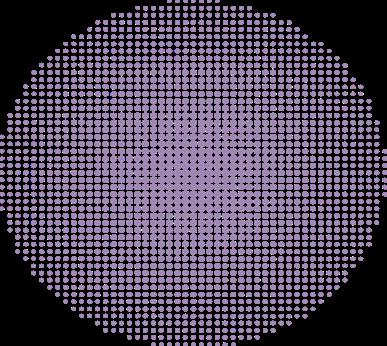
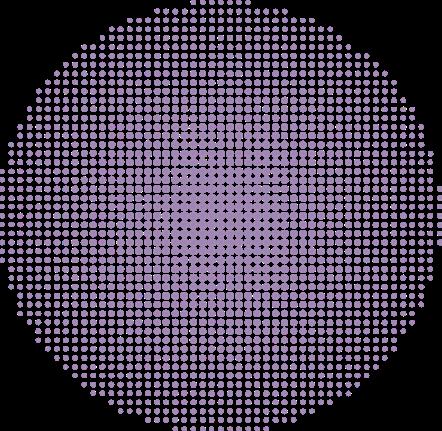
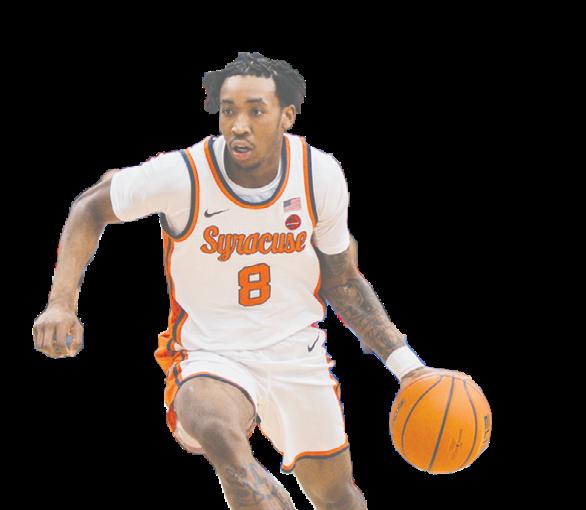
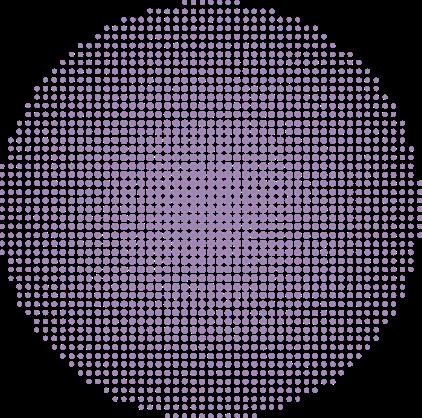

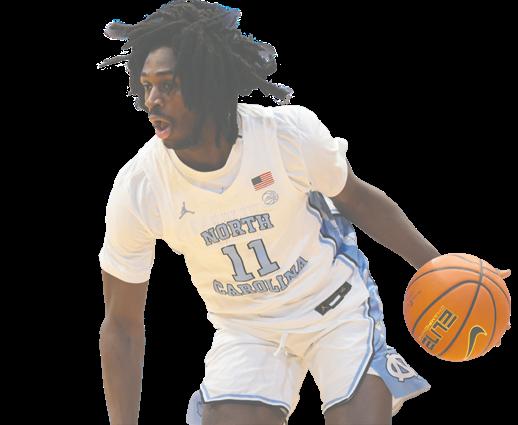
By Aiden Stepansky digital managing editor
Elijah Moore and Ian Jackson had a decision to make. Following three illustrious seasons with Cardinal Hayes High School in the Bronx where each scored over 1,000 points, the duo was offered to take their talents to a bigger stage — Overtime Elite.
Within the Atlanta-based league, a substantial travel schedule offered more visibility and greater Name, Image, and Likeness opportunities. When considering their next route, one thing was certain: they wouldn’t leave each other’s side.
“They came in and said that they were a package deal,” Cardinal Hayes head coach Joe Lods said. “They were going to stay together or leave together.”
Moore and Jackson chose the latter. From eighth grade through their senior year, the pair created one of the top backcourt tandems in the country across the AAU and high school circuits. They eventually split for college, where Moore is a starter for Syracuse while Jackson is starring for North Carolina. They’ll face for the first time in college when the Orange and Tar Heels match up Saturday.
“It’s a special moment between me and (Jackson),” Moore said. “Growing up with him and us competing together for as long as we did, and now we’re at this stage and we’re going against each other.”
“We helped each other and pushed each other to be great, and we got it done,” Jackson added. “Me and him never thought about playing in the ACC and being able to compete with each other at the highest level. But now it’s here.”
Moore and Jackson landed in the same conference but weren’t always viewed on the same playing field. Jackson, a McDonald’s All-American and the No. 8 player in the 2024 class, per 247Sports, was seen from the outside as the Alpha, Lods said. Moore held his own, too, ranked at No. 59, but was characterized as “the other one” compared to Jackson, said Pete Wehye, their coach at Our Savior Lutheran and Jelly Fam of OTE.
Their personalities only aided the idea of Moore playing second fiddle. Jackson said Moore is a mellow, calm presence, staying more conservative until he gets to know you. Jackson is more outgoing, described by their trainer Brian Harrington as a gregarious figure. At times, Jackson was the Batman to Moore’s Robin.
“I thought (Moore) always had a chip on his shoulder because he didn’t get the attention that (Jackson) got. You could see it,” Lods said. “(Jackson) was the cool guy, and (Moore) was hungry.”
After playing together at Our Savior Luthern in eighth grade and New York Wiz Kids AAU, they both moved on to Cardinal Hayes. As COVID-19 hit in 2020, New York’s restrictions forced Moore and Jackson to train elsewhere.
With the Bronx closed down, Wiz Kids coach Daman Brown drove the two to Connecticut,
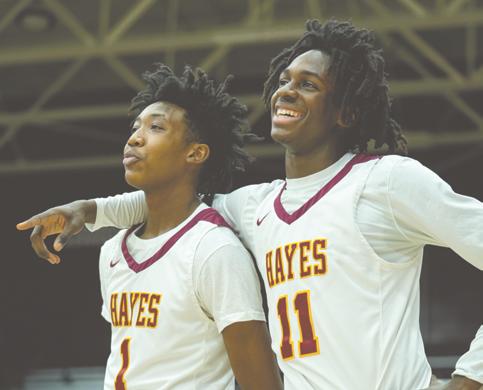
where they typically trained from 8 a.m. to noon, got lunch together and then returned to the gym.
When the season started and Jackson had an established role, Lods said Jackson vouched for Moore, knowing his potent shooting ability would translate to the varsity level.
Jackson was right. Moore quickly proved he was a varsity player, becoming a starter four games into the year. With 6-foot-8 forward Tobe Awaka down low, Moore’s deadeye shooting allowed the Cardinals to spread the floor. Lods said Jackson was protective of Moore, making sure he got the ball where he wanted it while continuously pouring confidence into him.
“Freshman year, everybody loved (Jackson),” Brown said. “(Jackson) was like ‘Don’t forget about my guy.’”
As sophomores in the 2021-22 season, Moore and Jackson helped the Cardinals to a 26-3 record. Through their playoff run, which ended in a city championship win over Archbishop Stepinac, Moore shot over 70% from beyond the arc, Brown said.
Jackson, a speedy, downhill slasher, and Moore, a lights-out shooter, were the perfect combination to pair in the backcourt. But as their high school years went on, and colleges came calling, it was apparent they needed to revert to each other’s games.
In their junior year, Jackson committed to UNC on Jan. 16, 2023, and Moore made his move to SU less than two weeks later. With one year left of high school and their futures known, the duo decided a change was needed.
They already accomplished what they set out to do — New York CHSAA First Team selections,
championships and AAU success. All that was left was to prepare for college. OSL afforded them that opportunity.
Late in summer 2023, just weeks before their senior year began, Moore and Jackson chose to finish what they started at OSL. The school had recently joined OTE, a league for high school players built to forge a path toward professional basketball.
Future NBA players like Alex Sarr, Rob Dillingham and twin brothers Amen and Ausar Thompson have participated since its inaugural 2021 season. Jackson and Moore were next up. At first, it was Jackson’s idea. Moore said he wasn’t sure about it, speculating if it was the right move. But the two made the switch.
“When they transferred and went to OSL, they were both like, ‘We’re going to do this together,’” former Wiz Kids coach Dominique Nute said.
Back with Wehye at OSL, they were a different duo than four years prior. Wehye said the way they criticized each other would be unacceptable to any other teammates. They became “truth tellers” in their senior year.
He often made the teams in practice so the two would match up. They went at each other, trash-talking and critiquing their games. It was brotherly love and competition at the same time.
“When we on that court, it’s war, and they understood how to separate the two,” Wehye said.
The duels in practice also allowed for precise chemistry once facing top-tier competition. Wehye described their bond as “synergy,” saying Moore and Jackson have been inseparable
since eighth grade. At times in OTE games, the two would simply nod and be on the same page, knowing a back-door cut or flare to the 3-point line was in play.
With OTE, the duo created their own brands while becoming the faces of Jelly Fam. With his notorious nickname “Captain Jack,” Jackson built an Instagram following of over 220k, became an Adidas-sponsored athlete and has a podcast powered by Overtime.
While often overshadowed by Jackson, Moore’s infamous elbow celebration helped him create his own identity. Known as “Choppa,” his marksman-like shooting ability mixed with a bullseye tattoo on his left elbow has become synonymous with elite shooting, building a brand of nearly 150 thousand followers on Instagram.
Together, the pair headlined the New York City basketball scene. Overtime Chief Growth Officer Tom Weingarten said all of the media team’s posts featured either Moore or Jackson because of their immense popularity. It propelled Jelly Fam to become one of the fastestgrowing social media accounts across all Overtime platforms.
Weingartner said the two never felt Moore was in Jackson’s shadow, and the separation came to light as they both came further into the spotlight. The Overtime media team often joked about who would take the last shot if Jelly Fam needed it, knowing that both would answer themselves. In battling for Jelly Fam and their paths to that stage, Jackson and Moore put NYC on their backs.
“(Jackson’s) the epitome of the flashy, big personality New York City player. He wore the crown of New York City,” Harrington said. “Moore is New York with his gritty attitude. Kind of his f-you, go at you on the court type thing.”
Now separated by over 600 miles and out of their home city, Moore and Jackson continuously stay in touch. In a group chat with Nute, Brown, Jackson, Moore and SU women’s basketball player Angelica Velez, the two often praise or critique each other on their recent performances.
Already trash-talking before their first college matchup, Wehye said both plan to use Moore’s elbow celebration in the other’s face after their first 3-pointer. No matter the outcome, the game between Moore and Jackson allows two childhood best friends to take the stage together, soaking in all they’ve gone through together and where they are now.
“That’s my brother,” Jackson said. “He’s grown so much. He’s helped me grow so much.”
“We had a whole bunch of battles together. And prior to those games, it was us battling at practice,” Moore said. “We learned from each other. We both love each other.”

By Justin Girshon sports editor
Syracuse’s upset over then-No. 7 North Carolina at the JMA Wireless Dome last year sparked a 5-2 record to end the regular season en route to clinching the program’s first 20-win campaign since 2018-19. However, the Orange — who bolster a new-look roster following nine departures from last year’s squad — have failed to capitalize on that momentum in Adrian Autry’s second year as head coach.
The newest low was a 91-84 loss to Miami, the worst team in the Atlantic Coast Conference, on Tuesday. Fighting to make the ACC Tournament, which the top 15-of-18 teams in the conference qualify for, the Orange now sit 14th in the conference standings.
Following the defeat, Syracuse returns home to face North Carolina. The Tar Heels, coming off a 20-point road loss to Clemson, have underperformed this season. But they still rank No. 45 in KenPom’s rankings and No. 51 in the Net Rankings.
Here’s everything to know before Syracuse’s (11-14, 5-9 ACC) matchup against North Carolina (14-11, 7-6 ACC):
All-time series
North Carolina leads 17-7.
Last time they played
After obliterating Syracuse 103-67 in Chapel Hill a month prior, North Carolina traveled to the JMA Wireless Dome on Feb. 13, 2024. The Tar Heels were ranked No. 7 in the country, while SU was coming off a home loss to Clemson.
However, the Orange collected their best win under Autry, upsetting UNC 86-79. After the
game was knotted 42-42 at halftime, Syracuse outscored North Carolina 44-37 in the second half to claim the victory. SU was propelled by Judah Mintz and J.J. Starling, who combined for 48 points on 17-of-26 shooting while playing the entire game.
Meanwhile, Maliq Brown (14) and Chris Bell (13) also scored in double figures. On the other side, the Tar Heels were led by RJ Davis’ 19 points while Cormac Ryan (18), Armando Bacot (14) and Harrison Ingram (14) reached double digits. Of all those players, Starling, Bell and Davis are the only players still with their respective programs.
KenPom odds
Syracuse has a 28% chance of winning, with a projected final score of 81-75.
The Tar Heel report
Following its loss to Syracuse in the 2023-24 season, North Carolina captured the ACC regularseason title by finishing conference play 17-3. The Tar Heels advanced to the ACC Tournament Championship but fell to future Final Four team NC State.
Still, they earned a No. 1 seed in the NCAA Tournament and reached the Sweet 16 before falling to Alabama. Despite losing Bacot, Ryan and Ingram, UNC was again expected to be an elite team in 2024-25, entering the season No. 9 in the AP Poll. Additionally, it was picked to finish second in the ACC’s Preseason Poll.
However, the preseason has been the peak of UNC’s season. Two games into the year, it dropped a narrow contest to now-No. 17 Kansas at Allen Fieldhouse. While that was still an encouraging early-season road result, the Tar Heels then dropped consecutive games to now-
No. 1 Auburn, now-No. 11 Michigan State and now-No. 2 Alabama.
The Tar Heels haven’t recovered since then, beating just one ranked team while holding a record of just over .500 in a relatively weak ACC. Though Davis’ production has fallen off, he’s still one of the best scoring guards in the conference and is supported by five-star freshman Ian Jackson and veterans Elliot Cadeau and Seth Trimble.
Arguably the biggest difference between last year’s North Carolina squad is its lack of an inside presence. With Bacot out of the picture, UNC’s primary big men pieces are Ven-Allen Lubin, Jalen Washington and Jae’Lyn Withers. They combine for 17.6 points and 13 rebounds per game. Last year, Bacot averaged 14.5 points and 10.3 rebounds himself.
How Syracuse beats North Carolina Per usual, the 3-point battle will be crucial for Syracuse. The Orange are coming in strong — at least for themselves — shooting 8-of-21 from distance against Miami. However, the Hurricanes made 10-of-20 3s en route to a seven-point win.
Heading into the matchup against the Tar Heels, SU’s 32.1% 3-point percentage ranks 262nd in the country. Meanwhile, North Carolina’s 32.3% clip ranks 248th. In a game that hypothetically should stay within a couple of possessions, 3-pointers could be the difference between UNC inching toward the NCAA Tournament bubble or SU getting breathing room toward making the ACC Tournament.
Stat to know: 16.67%
North Carolina enters the JMA Wireless Dome ranked 51st in the Net Rankings,
Jmaking it a Quad 2 opponent for Syracuse. Throughout the year, the Orange have consistently struggled against such teams, going 1-5 for a 16.67% winning percentage. SU’s lone win, though, was its last Quad 2 game against Cal. Meanwhile, the Orange have gone 0-7 versus Quad 1 teams.
On the flipside, this is considered a Quad 3 matchup for the Tar Heels, teams they’ve accumulated a 3-1 record against — only falling 72-71 to Stanford at home. Against Quad 4 opponents, North Carolina is 5-0.
Player to watch: RJ Davis, guard, No. 4
Davis, a fifth-year senior, has been one of the most prolific scorers in college basketball since his sophomore year. In UNC’s run to the 2022 NCAA Tournament title game, Davis exploded for 30 points in an overtime win over No. 1 seed Baylor in the round of 32 and added 18 in a Final Four win over Duke.
He averaged 13.5 points as a sophomore before improving to 16.1 as a junior. Then, following Caleb Love’s transfer to Arizona, Davis became the clear-cut No. 1 option in North Carolina’s offense and averaged an ACC-high 21.2 points per game last year.
However, he’s regressed to 17.4 points this season. The biggest difference has been the guard’s struggles from 3. Last year, he shot a career-best 39.8% from beyond the arc on 7.7 attempts per game. Thus far in 2024-25, Davis is shooting a career-worst 31.9% while attempting 6.6 3-pointers a contest.
justingirshon@gmail.com @JustinGirshon
.J. Starling’s mother, Satonya, loves to give analogies when describing her son’s ability to take over games. She likens it to watching a movie’s climax. It’s never a singular play that alerts her. Starling may hit a series of tough floaters or contested 3-pointers, but what remains the same is the unmistakable look in Starling’s eyes.
Starling’s father, Patrick, is the next to catch on. They turn to each other and smile, before watching Starling dominate down the stretch.
“It’s like when Superman goes into that telephone booth and changes,” Satonya said. “You see a totally different player.”
Starling, now in his second year with the program, often wears the superhero’s cape for Syracuse. After Judah Mintz’s departure in the offseason, the Orange needed Starling to step up and be the guy. A former McDonald’s All-American, Starling is accustomed to being a No. 1 option. This season, that’s been amplified, as he’s scoring a career-high 18.6 points per game — third amongst guards in the Atlantic Coast Conference.
With Mintz now in the NBA G League and SU’s next healthy leading scorer Eddie Lampkin Jr. averaging 10.0 points, Starling is taking four more shots than he did last season. But the Orange are two games under .500 and sit 14th in the ACC. It’s hard to blame Starling, though.
When he missed a seven-game stretch due to a broken wrist, Syracuse won just two games.
Since Starling’s return on Jan. 4, SU’s been inconsistent, going 5-6. What is consistent is the Orange’s reliance on Starling.
SU’s lack of perimeter creators puts pressure on Starling to play well. When he does, good things happen for Syracuse. It’s 5-3 in games where Starling scores at least 20 points. That includes SU’s recent triple overtime win over Boston College. He’s shown he can singlehandedly lead the Orange to victory. This was seen best earlier in the season against BC, Notre Dame and Youngstown State.
“Just be aggressive and make plays at the end of the day,” Starling said of his mindset. “My coaches and my teammates trust me to do that. They put me in situations to go out and do that. So I’m just looking forward to closing out the game.”
By Zak Wolf senior staff writer
On Nov. 16 against Youngstown State, Starling scored 21 of his career-high 38 points in the game’s second half. In his third game back from injury on Jan. 11, he accumulated 20 of his 26 after the break. Starling also poured in 16 second-half points against Notre Dame on Jan. 18, as Syracuse overcame a 17-point deficit.
“When he’s locked in scoring, his focus is different,” Syracuse head coach Adrian Autry said. “His energy changes a little bit and there’s not a lot of hesitation. He’s way more decisive once he gets locked in.”
Despite sitting at the top of opposing teams’ scouting reports, Starling has remained undeterred. Syracuse needs the point guard to be superhuman at times to win. That comes with pressure. Some might fold under it. Starling relishes it.
“There’s no pressure because at the end of the day, I don’t look at it like a job,” Starling said.
Last season, Starling’s role was different. After transferring from Notre Dame, he took a backseat to Mintz — then SU’s leading scorer — and played hesitantly. In five straight games from late December to early January, Starling was held to single digits and didn’t take more than nine shots.
Mintz took issue with Starling’s lack of aggression, knowing he could reach another level. The two had played against each other since middle school, when Starling’s Albany City Rocks squad faced Mintz’s Team Takeover.
Mintz implored Starling to take more shots, and he listened. Across Syracuse’s final 15 regular-season games last season, Starling averaged 16 points, compared to 11 in the first 16.
“He’s too good to not be aggressive,” Mintz said.
It’s something Starling’s grappled with his entire career, dating back to his time playing varsity as an eighth grader for Baldwinsville’s Baker High School, just 20 minutes from SU. With his prowess as a three-level scorer, Starling immediately became Baker’s best player. Mike Lewis, Baldwinsville Baker’s head coach, said Starling saw things on the court kids his age usually don’t, but was never rattled under pressure.
Despite Starling’s advanced knowledge and skill levels, he didn’t always leverage them into an attacking mindset.
“He was always willing to make the players around him better, instead of being the best player on the floor every single night trying to get every shot,” Lewis said.
Sometimes it came down to how he was guarded. Starling often drew double teams whenever he touched the ball, and as soon as he gave it up, he was face-guarded to prevent him from getting it back, Lewis said.
Content with letting his teammates benefit from his gravity, Starling played selflessly. When it was time to push the right buttons and be in control, he was. Starling’s lightning-quick drives and pull-up jumpers became routine, which are still his go-tos with Syracuse.
He was an All-State performer as a freshman and sophomore in high school, helping Baker to a sectional final in 2020. Starling’s marquee performance that season came in a nonconference game against Green Tech from Albany.
Jim Hart, the director of Albany-based City Rocks, attended the contest. Before the game, Hart told his friends it could be tough for Starling, who was 15, against Green Tech, a program with multiple state championships.
Hart was wrong. By halftime, Starling had 25 points and made seven 3s. He finished with 35 points and 10 triples in a win. After the game, Hart sent the film to Duke’s then-assistant John Scheyer, and the Blue Devils started recruiting Starling.
“It was just crazy, he was just stepping into shots and hitting things that were next level,” Hart said.
Eventually, Starling left central New York to attend La Lumiere, a preparatory school in Indiana where he played under Patrick Holmes. The competition was stiffer, but Starling was still the go-to guy alongside Division I prospects like Michigan State point guard Jeremy Fears Jr., Alabama guard Aden Holloway and Notre Dame forward Kebba Njie.
“He was a guy that, in crunch time, the ball was in his hands to make the right play,” Holmes said.
Starling became a consensus five-star recruit. He stayed in the Midwest playing for Notre Dame, where he became the lone non-
senior in its starting lineup. He was a doubledigit scorer with 11.2 points per game, but the ball wasn’t in his hands as much. Notre Dame head coach Mike Brey left that offseason, and so did Starling.
He came home to Syracuse. After waiting in the wings behind Mintz last year, Starling, a self-described “quiet guy,” has been pushed out of his comfort zone in a leadership position this season.
“I’m forcing myself, along with my coaches and my teammates, having that standard, to really stay with that and just push ourselves,” Starling said.
Things haven’t been perfect. Syracuse may finish under .500 for just the second time in the past 50 years. But Starling doesn’t — nor should he — get much of the blame for its shortcomings.
He was on the sidelines for a month due to injury. During that time, Starling grew impatient. Patrick said Starling felt he was letting the team down due to him not being out there.
“He was very antsy to get back on the court,” Patrick said. “That’s his attitude …when he’s focused, it is almost like nobody can stop him from making his mind up.”
To pass the time, he watched hours of film each day; not just on himself, but on other elite college guards. Starling pointed to Alabama’s Mark Sears and North Carolina’s RJ Davis specifically. He took note of both because of their elite ability to navigate pick-and-rolls to get downhill and score.
Both Sears and Davis have led their respective programs to Final Fours. Starling is far from that. Yet, when healthy, he’s one of the top guards in the ACC.
Basketball can be a simple game. Sometimes all that’s needed is to put the ball in your best player’s hands. For Syracuse, that means giving the ball to Starling. Opposing teams know that. There isn’t always much they can do to stop him. “He’s everything for this team. He’s our leader and the team knows it,” Autry said.

